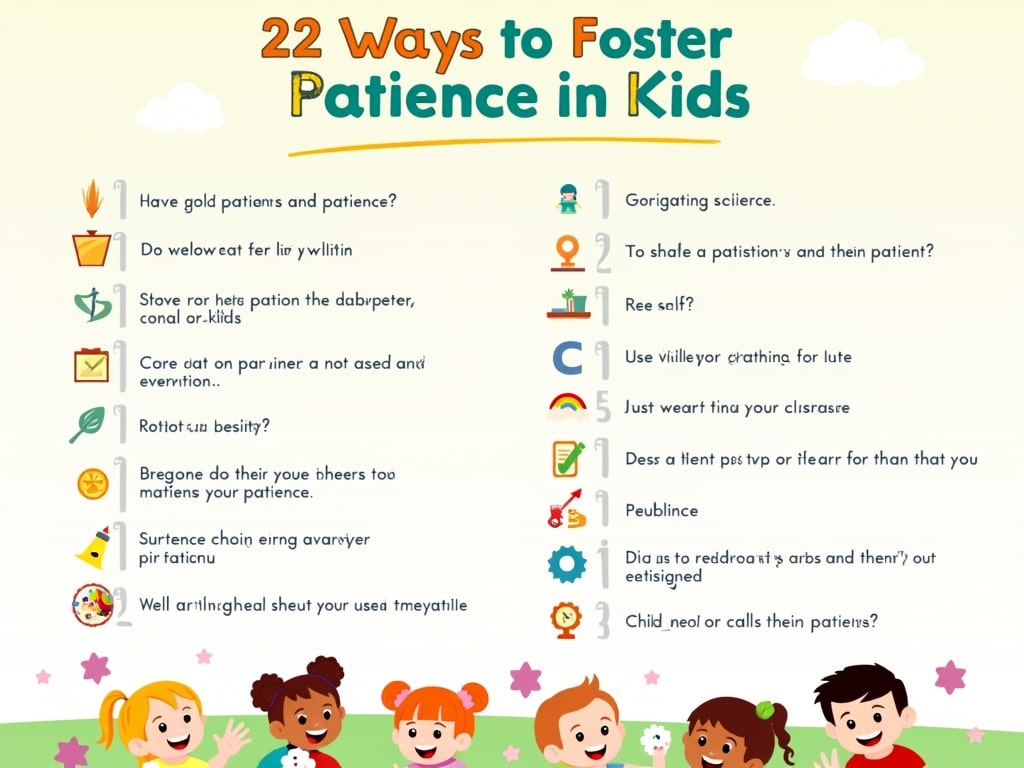
Patience in Children
Cultivating patience in children is a cornerstone of their emotional and social development, particularly in a world dominated by instant gratification. Teaching kids how to wait, delay rewards, and manage their emotions equips them with lifelong tools for problem-solving, emotional wellness, and adaptability. Here are 22 expert-backed recommendations to help nurture patience in your child.
1. Start with Role Modeling Patience
Children emulate what they see. Demonstrate patience during stressful or mundane moments, such as waiting in line or handling interruptions. Your behavior serves as a blueprint for them to follow.
2. Practice Mindful Awareness Together
Introduce mindfulness activities like breathing exercises or guided meditations. These practices help children become more aware of their emotions, encouraging them to pause and reflect before reacting impulsively.
3. Set Realistic Expectations
Make sure your child understands the value of waiting by starting with small, achievable tasks. For instance, have them wait five minutes for their favorite treat and gradually increase the time.
4. Teach the Importance of Delayed Gratification
Discuss the benefits of waiting for something worthwhile. Share relatable stories, such as saving money for a coveted toy, to illustrate the payoff of patience.
5. Use Games to Teach Patience
Games like puzzles, board games, or Simon Says can foster patience by requiring children to wait for their turn or focus on completing a task step by step.
6. Reward Patience with Positive Reinforcement
Praise your child when they demonstrate patience. Recognizing their effort reinforces the behavior, making them more likely to repeat it.
7. Incorporate Waiting Periods in Daily Routines
Introduce structured waiting times, such as sitting at the dinner table before meals are served, to make patience a natural part of their day.
8. Encourage Journaling or Drawing
Provide them with a journal or art supplies to express their emotions. This creative outlet helps channel feelings of frustration that often arise during moments of waiting.
9. Limit Instant Rewards
Resist the urge to satisfy every demand immediately. Encourage children to wait for their favorite show or snack, teaching them to appreciate delayed rewards.
10. Read Stories with Themes of Patience
Share books or tales that emphasize the importance of patience. Characters overcoming obstacles through perseverance can leave a lasting impression.
11. Use Visual Timers
A visual timer helps younger children grasp the concept of time. Watching the countdown helps them understand the process of waiting.
12. Promote Empathy
Encourage your child to consider other people’s feelings. When they understand how impatience affects others, they may be more willing to exhibit patience.
13. Organize Activities That Require Step-by-Step Effort
Cooking, gardening, or crafts are great ways to teach patience. These activities reward children with visible results for their perseverance.
14. Create a Calm Environment
A chaotic atmosphere can exacerbate impatience. Maintain a calm and orderly home environment to support your child’s ability to remain composed.
15. Celebrate Small Wins
Every instance of patience deserves recognition. Acknowledging these small wins builds their confidence and resilience.
16. Discuss Real-Life Scenarios
Talk about situations where patience plays a key role, such as studying for an exam or training for a sport. Relatable examples make the lesson tangible.
17. Limit Screen Time
Excessive screen time fosters instant gratification, making it harder for kids to be patient. Set boundaries to encourage alternative, patience-building activities.
18. Foster Collaborative Play
Group activities like team sports or cooperative games help children practice waiting their turn and understanding the importance of shared goals.
19. Teach Problem-Solving Skills
When children learn how to resolve conflicts or delays effectively, they feel more empowered and less likely to become frustrated while waiting.
20. Address Impatience Calmly
When your child struggles, remain calm and guide them through the situation. Teach them to take deep breaths and reframe negative emotions.
21. Share Patience-Oriented Challenges
Create challenges where patience is rewarded, such as planting a seed and watching it grow. These experiences illustrate the beauty of waiting.
22. Be Patient with Their Progress
Learning patience is a journey. Support your child’s efforts with understanding and kindness as they navigate this developmental milestone.
Key Takeaways
- Model Patience: Children learn best by observing their parents’ behavior.
- Incorporate Daily Practice: Embed patience-building activities in routines.
- Positive Reinforcement: Celebrate and praise patient behaviors.
- Creative Outlets: Provide tools like art or journaling to manage emotions.
- Limit Instant Gratification: Introduce the value of waiting for rewards.
FAQs
1. Why is teaching patience important for children?
Patience helps children develop emotional resilience, improve problem-solving skills, and navigate social interactions more effectively.
2. At what age can children start learning patience?
Children as young as toddlers can begin learning patience through simple practices, such as waiting for a toy or snack.
3. What are some simple ways to teach patience at home?
Engage in activities like reading, cooking, or collaborative games, and incorporate structured waiting times into daily routines.




